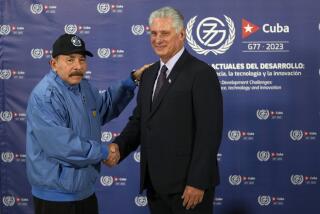MILITARY : Controversial General Finally Ready to Bow Out in Nicaragua
- Share via
MANAGUA, Nicaragua — The last time President Violeta Barrios de Chamorro tried to fire Gen. Humberto Ortega, the powerful army chief lashed out publicly at government officials for having “sold out” to pressure from Washington. He refused to budge.
Months later, Ortega has finally agreed to step down, having successfully delayed his retirement date by more than a year.
The Ortega episode underscores the difficulties the Chamorro government has experienced as it struggles to bring the army, dominated by leftist Sandinistas, under civilian control.
“Nicaragua will have for the first time in its history a national army, clearly subordinated to civilian power, committed to the constitution, that does not belong and is not subordinated to the interests of any political party or social class,” Chamorro said in a ceremony last week to announce Ortega’s departure.
“The years of armies that belong to parties, which made the birth of democracy so difficult in Nicaragua, are now behind us,” she said.
In addition to changing the army chief, the government has finally drafted a long-awaited military code that for the first time gives the president formal authority over the army commander. It also sets term limits for senior officers.
Still, despite Chamorro’s stated intentions, Sandinista influence on the army will not end with Ortega’s departure next year. His likely successor is Maj. Gen. Joaquin Cuadra, another veteran Sandinista. And the officer corps remains Sandinista.
Chamorro defeated former President Daniel Ortega, Humberto’s brother, and the Sandinista Front in presidential elections in 1990. She named herself defense minister but stunned her followers by retaining Humberto Ortega as army chief, saying his presence was necessary to ensure the peaceful downsizing of Nicaragua’s huge military apparatus.
U.S. officials and Chamorro’s conservative critics denounced that decision, arguing that continued Sandinista control of the army would forever limit the civilian president’s ability to govern. Demanding Ortega’s removal, the critics maintained that the army could not become a professional and nonpolitical force as long as he and other key Sandinistas remained in top positions.
Sandinista domination of security forces was one of the reasons the United States gave for withholding millions of dollars in aid last year.
Chamorro tried to dump Ortega in September, when she announced his retirement at an Army Day ceremony. Shocked and furious, Ortega stormed up to the president and said she had exceeded her authority. She could not remove him, he told her.
But now the two have negotiated what the Sandinista newspaper Barricada called “a dignified withdrawal.” Ortega will formally step down Feb. 21, 1995, the 100th anniversary of the birth of Augusto Cesar Sandino, the guerrilla who fought U.S. Marines occupying Nicaragua in the 1920s and 1930s and for whom the Sandinista National Liberation Front is named.
“The military has professed to be professional and nonpolitical, and at the same time we know that the whole corps of officers is Sandinista,” a diplomat said. “It will be up to them to show they are professional and nonpolitical.”
The Sandinista People’s Army swelled to become the largest army in Central America during the 1980s, as it battled U.S.-backed Contra rebels. It has been reduced dramatically, according to government figures, from more than 85,000 troops to 14,000.
Critics say the army became Ortega’s personal fiefdom, which he used after the war to get rich and operate above the law. In one particularly notorious case, Ortega and eight bodyguards have been accused of shooting and killing a 16-year-old youth who tried to drive past Ortega’s convoy on a city highway in 1990.
It is not clear what finally forced Ortega to accept retirement now. However, he has told Nicaraguan reporters that he is interested eventually in running for president.
More to Read
Sign up for Essential California
The most important California stories and recommendations in your inbox every morning.
You may occasionally receive promotional content from the Los Angeles Times.














